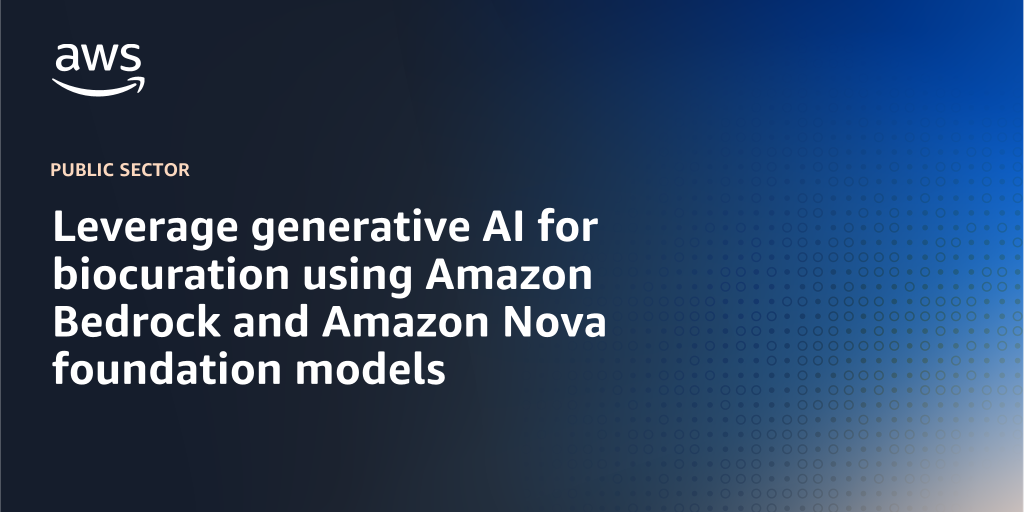AWS Public Sector Blog
Category: AWS Lambda
Breaking barriers: How AWS is revolutionizing the accessibility of federal agency communications for people with visual disabilities
In this post, we discuss a solution that uses AWS services to improve government communication accessibility and meet federal accessibility requirements. The serverless architecture automates document-to-speech conversion and delivers information to citizens with visual disabilities.
Transforming Resident Outreach using next-generation AI capabilities
Deloitte’s Resident Outreach solution (available in AWS Marketplace) enables state agencies to adapt their resident communications through the power of generative AI on AWS. In this post, we discuss how Deloitte empowers the four capabilities of Resident Outreach: Multi-Modal Completion of Applications & Renewals, Application Nudges, Correspondences, and Campaigns.
From inaccessible to inclusive: How the new PDF accessibility remediation solution helps institutions compliantly address accessibility requirements
Public entities must make sure that their digital content is accessible for people with disabilities. PDF documents can present challenging accessibility issues. In this post, we discuss an innovative, open source, and AI-driven solution to automate the remediation of these PDFs and bring them into compliance with Web Content Accessibility Guidelines (WCAG) 2.1 standards.
Tagging governance using AWS Organizations in the public sector
When Department of the Air Force (DAF) software factories scale their cloud operations across mission-critical environments, maintaining consistent resource tagging becomes crucial for security, compliance, and operational effectiveness. For organizations like Kessel Run, a unit that provides capabilities within the DAF Battle Network, ensuring compliance while maintaining rapid deployment capabilities is essential for delivering capabilities to warfighters. In this post, we discuss a solution that enabled Kessel Run to enforce tagging standards at resource creation while supporting their complex deployment patterns.
How AWS IoT services address NIST 800-183: Networks of ‘Things’
In this post, we will explore AWS IoT services in the context of NIST Special Publication 800-183: Networks of ‘Things’. NIST 800-183 presents a model for expressing IoT deployments and establishes concerns about the trustworthiness of the Internet of Things, which AWS IoT services can help public sector organizations address. We will delve into key areas such as authentication, monitoring, and secure communication.
How the AI for Teaching & Learning Framework on AWS is transforming the student and teacher experience
In this blog post, we explore the AI for Teaching & Learning Framework on AWS, and discuss how it is addressing the evolving needs of higher education in the digital age.
Cal Poly seeks to transform procurement process with generative AI-powered scope of work generation
In today’s complex procurement landscape, creating comprehensive and accurate statements of work scopes can present a challenge for university procurement teams. To address this growing challenge, the Digital Transformation Hub (DxHub) at Cal Poly—powered by Amazon Web Services (AWS) and part of the AWS Cloud Innovation Centers (CIC) program—took action. The DxHub collaborated with the university’s Strategic Business Services department to create “Scope Builder,” a generative AI-powered application that aims to revolutionize how procurement specialists develop work scopes for university requests for proposals (RFPs) and contracts.
AWS transforms DC police department’s data processing system by utilizing Spark on Lambda
The Metropolitan Police Department of Washington DC (DC-MPD) is one of the ten largest police agencies in the United States, serving as the primary law enforcement entity for the District of Columbia. Embracing cutting-edge technology provided by AWS, DC-MPD has integrated evidence analysis techniques with state-of-the-art information technology to advance crime-mapping, real-time crime statistics dashboards, and summary statistics for a holistic view of crime dynamics.
Leverage generative AI for biocuration using Amazon Bedrock and Amazon Nova foundation models
Personalized therapy for diseases such as cancer utilizes an individual’s unique genomic profile to guide treatment decisions. However, the effect and clinical significance of most genetic variants are uncertain. Accurate classification of the clinical significance of novel genetic variants requires extensive curation of peer-reviewed biomedical literature. In recent years, generative AI has demonstrated promising results in information extraction and text summarization. In this post, we explore how various AWS-native solutions can be used to create a secure, retrieval-augmented, and cost-effective biomedical chatbot designed to facilitate biocuration.
How Fair Trade USA uses AWS to improve working conditions for farmers
Fair Trade USA™ is a nonprofit organization that is committed to eliminating poverty by promoting sustainable development through ethical trade. They work to ensure fair compensation, safe working conditions for farmers and workers, and sustainable farming practices. In this post, you’ll learn how Fair Trade USA leverages Amazon Web Services (AWS) to improve working conditions for farmers and producers around the world.









